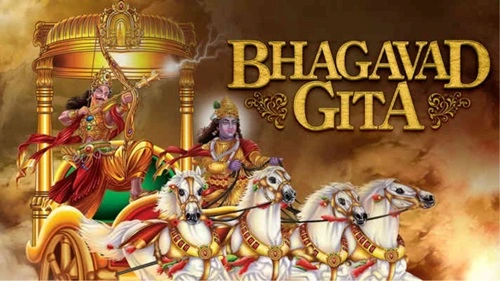The Bhagavad Gita is one of the most important and respected spiritual texts in the world. It is part of the Mahabharata, an ancient Indian epic, and is considered a guide for living a good and meaningful life. The Gita contains teachings from Lord Krishna to the warrior Arjuna on the battlefield of Kurukshetra. These teachings are not only about war but also about how to face challenges in life with wisdom and peace. Let’s discover some interesting facts about the Bhagavad Gita that make it special.

1. Part of the Mahabharata
The Bhagavad Gita is a section of the larger epic, the Mahabharata, which is one of the longest poems in the world. The Gita comes in the Bhishma Parva (book) of the Mahabharata and has 700 verses. The conversation between Krishna and Arjuna happens just before the great battle of Kurukshetra begins.
2. A Dialogue Between Krishna and Arjuna
The Bhagavad Gita is a conversation between Lord Krishna and the warrior prince Arjuna. When Arjuna is confused and upset about fighting in the war against his own family, Krishna explains to him the duties of a warrior and the deeper meaning of life, karma (action), and dharma (duty). Krishna’s teachings help Arjuna overcome his fear and doubts.
3. Teachings for All
The teachings in the Bhagavad Gita are not just for warriors or people involved in battles. They are universal and can help anyone who faces challenges in life. The Gita teaches about how to handle problems, make decisions, and live a life filled with peace, love, and righteousness. It tells us to do our duty without worrying about the results, which is known as “Karma Yoga.”
4. Divided into 18 Chapters
The Bhagavad Gita is divided into 18 chapters, each focusing on different aspects of life and spirituality. These chapters explain concepts like karma (actions), bhakti (devotion), and jnana (knowledge). The chapters guide people on how to balance their duties with spiritual growth and inner peace.
5. Written in Sanskrit
The Bhagavad Gita was originally written in Sanskrit, one of the oldest languages in the world. Even today, the Gita is read in its original Sanskrit form by many people. However, it has also been translated into almost every language, making it accessible to people all over the world. You can now find the Bhagavad Gita in Hindi, English, and other languages, making it easy for everyone to understand its wisdom.
6. Philosophy of Karma
One of the key teachings of the Bhagavad Gita is the concept of karma, or actions. Krishna tells Arjuna that every person must perform their duties without worrying about the outcome. This means we should do our work with honesty and dedication, but not be attached to the results. This teaching helps us live without stress and fear of failure.
7. Bhakti Yoga – The Path of Devotion
Another important lesson in the Bhagavad Gita is the concept of Bhakti Yoga, or the path of devotion. Krishna explains that loving and being devoted to God is one of the easiest ways to achieve inner peace and spiritual growth. By surrendering to God with a pure heart, one can find happiness and freedom from worries.
8. Jnana Yoga – The Path of Knowledge
In the Bhagavad Gita, Lord Krishna also talks about Jnana Yoga, or the path of knowledge. This path teaches people to understand the true nature of life and the self. By gaining wisdom and knowledge, a person can overcome ignorance and understand the deeper meaning of existence. The Gita encourages people to seek knowledge and use it to improve their lives.
9. The Bhagavad Gita’s Influence on Famous Leaders
The Bhagavad Gita has inspired many famous leaders and thinkers around the world. Mahatma Gandhi, who led India to independence, often spoke about how the Gita gave him strength and courage during tough times. Other leaders like Swami Vivekananda and Dr. A.P.J. Abdul Kalam also found inspiration in the teachings of the Gita.
10. Timeless Wisdom
Even though the Bhagavad Gita was written thousands of years ago, its teachings are still relevant today. Whether you are a student, a working professional, or someone trying to find peace in life, the Gita’s wisdom can guide you. It teaches us to live a life filled with purpose, respect, and compassion for others.
11. The Gita and Yoga
The Bhagavad Gita also discusses different forms of yoga, which are not just physical exercises but spiritual practices. There are four main types of yoga mentioned in the Gita: Karma Yoga (the yoga of action), Bhakti Yoga (the yoga of devotion), Jnana Yoga (the yoga of knowledge), and Raja Yoga (the yoga of meditation). Each type of yoga helps a person grow spiritually and achieve inner peace.
Conclusion
The Bhagavad Gita is more than just a religious text – it is a guide to living a meaningful life. Its teachings on duty, devotion, knowledge, and action have inspired people for centuries. No matter who you are or where you live, the Bhagavad Gita’s wisdom can help you overcome challenges and lead a peaceful and happy life.



